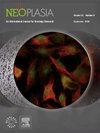Enhanced resistance to tamoxifen by the c-ABL proto-oncogene in breast cancer.
IF 7.7
2区 医学
Q1 ONCOLOGY
引用次数: 28
Abstract
Targeting the estrogen receptor is an important strategy in breast cancer therapy. However, although inhibiting estrogen receptor function with specific estrogen receptor modulators can achieve a primary response in cancer patients, intrinsic or subsequently acquired resistance to the therapy remains a major obstacle in the clinic. Thus, it is critical to gain a more thorough understanding of how estrogen receptor functions are regulated in breast cancer.Here, we demonstrate that the non-receptor tyrosine kinase c-ABL is a functional partner of the estrogen receptor, as expression of c-ABL sustained transcriptional activity of the estrogen receptor. More importantly, inhibition of c-ABL resulted in sensitization to treatment by tamoxifen (TAM) in estrogen receptor-positive breast cancer cells, as manifested by inhibition of cell survival and suppression of anchorage-independent growth. We found that c-ABL interacts with estrogen receptor in breast cancer cells and that expression of c-ABL is a frequent event in primary breast cancer tumor tissues. In estrogen receptor-positive tumors, the expression of c-ABL significantly correlated with disease progression and metastasis. This study shows that c-ABL regulates the cellular response to TAM through functional interaction with the estrogen receptor, which suggests c-ABL as a therapeutic target and a prognostic tumor marker for breast cancer.乳腺癌中c-ABL原癌基因增强对他莫昔芬的耐药性。
靶向雌激素受体是乳腺癌治疗的重要策略。然而,尽管用特异性雌激素受体调节剂抑制雌激素受体功能可以在癌症患者中获得原发性应答,但对治疗的内在或随后获得性耐药仍然是临床的主要障碍。因此,更深入地了解雌激素受体的功能在乳腺癌中是如何调节的是至关重要的。在这里,我们证明了非受体酪氨酸激酶c-ABL是雌激素受体的功能伙伴,因为c-ABL的表达维持了雌激素受体的转录活性。更重要的是,抑制c-ABL导致雌激素受体阳性乳腺癌细胞对他莫昔芬(TAM)治疗增敏,表现为抑制细胞存活和抑制锚定非依赖性生长。我们发现c-ABL在乳腺癌细胞中与雌激素受体相互作用,并且c-ABL的表达在原发性乳腺癌肿瘤组织中是一个常见的事件。在雌激素受体阳性肿瘤中,c-ABL的表达与疾病进展和转移有显著相关性。本研究表明,c-ABL通过与雌激素受体的功能相互作用调节细胞对TAM的反应,提示c-ABL可作为乳腺癌的治疗靶点和预后肿瘤标志物。
本文章由计算机程序翻译,如有差异,请以英文原文为准。
求助全文
约1分钟内获得全文
求助全文
来源期刊

Neoplasia
ONCOLOGY-
自引率
2.10%
发文量
82
期刊介绍:
Neoplasia publishes the results of novel investigations in all areas of oncology research. The title Neoplasia was chosen to convey the journal’s breadth, which encompasses the traditional disciplines of cancer research as well as emerging fields and interdisciplinary investigations. Neoplasia is interested in studies describing new molecular and genetic findings relating to the neoplastic phenotype and in laboratory and clinical studies demonstrating creative applications of advances in the basic sciences to risk assessment, prognostic indications, detection, diagnosis, and treatment. In addition to regular Research Reports, Neoplasia also publishes Reviews and Meeting Reports. Neoplasia is committed to ensuring a thorough, fair, and rapid review and publication schedule to further its mission of serving both the scientific and clinical communities by disseminating important data and ideas in cancer research.
 求助内容:
求助内容: 应助结果提醒方式:
应助结果提醒方式:


